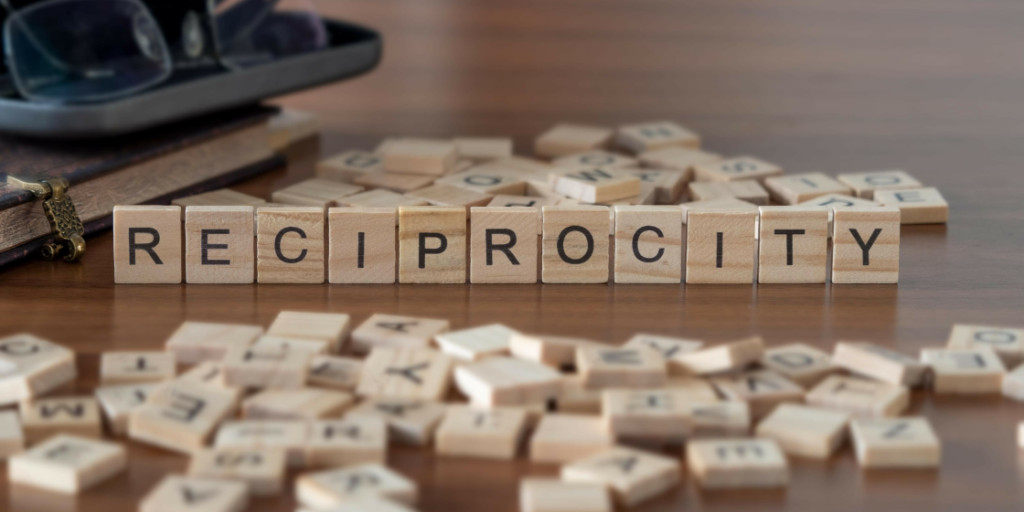Home / Blog / Marketing & Branding Advice / The Psychology of Giving – How Branded Gifts Influence Customer Behavior
The Psychology of Giving – How Branded Gifts Influence Customer Behavior
Date posted: 22nd November 2024 in Marketing & Branding Advice
Last updated: 2nd September 2025

Quick Overview
Branded gifts have a powerful psychological effect on customer behavior. This article explores how the act of giving builds positive associations, fosters loyalty, and encourages repeat business. We break down the science of reciprocity and how it applies to promotional marketing. Whether it’s a simple giveaway or a premium corporate gift, the right item can influence buying decisions. Learn how to use gifting strategically to connect with your audience.
Imagine receiving a well-designed reusable coffee cup or a handy tote bag at an event. It’s not just another freebie to stuff in a drawer – it’s something practical, something you’ll likely use. And every time you do, you’re reminded of the brand that gave it to you. This is the subtle, effective power of branded gifts.
Far from being a simple giveaway, these items tap into the psychology of giving and receiving, leaving a lasting impression and influencing behavior in ways that other forms of advertising often can’t. Let’s explore how branded gifts or swag impact brand recognition, loyalty, and purchasing decisions – and why they remain a cornerstone of effective marketing.
Why Tangibility Matters
In a world saturated with digital ads, tangible products stand out. A branded gift doesn’t disappear when you close a browser window or scroll past a social media post. Instead, it becomes a part of daily life – something you hold, use, and see repeatedly.
Take, for example, the everyday items we use without much thought: a pen, a mug, or even a tote bag. Studies show that 83% of people can recall the company behind a promotional product they received in the past year, much higher than recall rates for digital or TV ads. This staying power comes from the physical presence of the gift – it’s a constant, unobtrusive reminder of the brand that gave it.
The Emotional Connection of Giving
At its core, the psychology of giving is about reciprocity. When someone receives a gift, they naturally feel more positive toward the giver. In marketing, this translates into a boost in customer perception and loyalty.
For example, imagine being handed a high-quality branded notebook at an event. It feels like a small, thoughtful gesture, and it subtly influences how you see that brand. Research backs this up: over 50% of consumers say their impression of a brand improves after receiving a promotional product. It’s not just the item itself but the thought behind it that resonates, fostering goodwill and trust.
The Subtle Push Toward Purchase Decisions
Branded gifts are more than just nice gestures – they’re strategic. They create a sense of value that extends beyond the item, subtly influencing consumer behavior. When someone receives something useful or well-designed, they associate that quality with the brand itself, making them more likely to purchase from it.
For instance, let’s say you receive a practical item like a phone stand or a reusable shopping bag. Every time you use it, you’re reminded of the brand behind it. It’s no surprise, then, that 57% of people are more likely to make a purchase from a company that gave them a promotional product. It’s an understated, but powerful nudge toward loyalty and action.
Understanding Your Audience: The Key to Effective Gifting
Not all promotional products have the same impact, and much of their effectiveness depends on how well they align with the audience’s preferences. Demographics play a significant role here:
- Younger generations (Millennials and Gen Z) often lean toward tech-related gifts like branded wireless chargers or custom USB drives. These items fit seamlessly into their tech-savvy lifestyles.
- Older generations (Gen X and Baby Boomers) are more likely to appreciate practical gifts like reusable water bottles, tote bags, or kitchen accessories –items that combine usefulness with a touch of thoughtfulness.
The real magic lies in choosing items that feel relevant and thoughtful to the recipient. After all, 88% of people remember the brand behind a useful promotional item, making this alignment critical to long-term brand recall.
The Growing Importance of Sustainability
Sustainability is no longer just a buzzword – it’s a significant factor in how consumers perceive brands. Branded gifts that reflect eco-conscious values, like reusable bamboo utensils or recycled notebooks, not only appeal to environmentally aware consumers but also signal that the brand cares about its impact on the planet.
Data supports this shift: over 50% of consumers now prefer promotional products that are eco-friendly. By choosing sustainable options, brands not only cater to modern consumer preferences but also position themselves as responsible and forward-thinking – a win-win for both brand image and audience connection.
More Than a One-Time Impact
One of the greatest strengths of promotional products is their longevity. Unlike digital ads, which are fleeting, branded gifts stay with recipients for months, sometimes years. And they don’t just impact the person who receives them – they can also influence everyone who sees them.
Take a branded tote bag, for example. Every time it’s used at a supermarket, a gym, or on a commute, it’s seen by others. This ripple effect amplifies the value of the initial gift, turning it into a cost-effective marketing tool that keeps delivering.
Case Studies: Success in Action
The impact of branded gifts is best understood through real-world examples:
- Salesforce: As a leading player in customer relationship management (CRM) software, Salesforce distributed branded wireless chargers at Dreamforce, their annual industry conference. The chargers, imprinted with the company logo and a sleek design, were a huge hit among attendees. Over 70% of recipients reported a positive impression of Salesforce, associating the brand with innovation and thoughtfulness. The initiative led to a 25% increase in sales inquiries in the following quarter, demonstrating how a useful branded gift can translate into tangible business outcomes.
- Patagonia: Known for its commitment to sustainability, Patagonia introduced a loyalty initiative where customers received custom tote bags made from recycled materials with every purchase above a certain amount. The initiative not only aligned with Patagonia’s environmental values but also resonated with its eco-conscious audience.
The campaign resulted in a 40% increase in membership sign-ups for their Common Threads Partnership program. Additionally, the tote bags, often seen in public spaces, reinforced Patagonia’s reputation as a sustainable brand.
These case studies highlight how thoughtfully chosen branded gifts can drive business growth while enhancing brand identity and loyalty.
Tips for Maximizing the Impact of Branded Gifts:
To make the most of promotional products, it’s essential to be strategic:
- Know your audience: Choose items that align with the interests and values of your target demographic.
- Invest in quality: A poorly made product can backfire, leaving recipients with a negative impression of your brand.
- Be intentional: Make sure the gift ties back to your brand identity or campaign goals.
- Pick the right moment: Timing matters. Distributing gifts during key moments, like a product launch or holiday season, can amplify their impact.
The Future of Branded Gifts
As consumer preferences evolve, promotional products are adapting to stay relevant. Personalization is becoming increasingly popular, with brands customizing items to reflect the recipient’s name or interests. Sustainability, too, will continue to shape the industry, with more brands opting for eco-friendly materials and practices.
Digital integration is also on the rise – think QR codes on branded items that link to exclusive content or promotions. These innovations ensure that promotional products remain engaging, memorable, and effective in a fast-changing marketing landscape.
Final Thoughts
Branded gifts are much more than just marketing tools – they’re a way to connect with people on a deeper level. By offering something useful, thoughtful, and aligned with your audience’s values, you can leave a lasting impression that goes beyond the initial gesture.
Whether you’re a small business looking to build awareness or a well-established brand aiming to deepen customer loyalty, promotional products offer a proven path to success. When done right, they not only enhance brand recognition but also foster trust and drive meaningful results.
Sources

Strengthen your brand perception with promotional products
Chat online or call us today on 1800-586-1615
More Articles

5 Statistics That Prove Promotional Merchandise Actually Works.
24th January 2023 in Marketing & Branding Advice

A Complete Guide to Custom Keychains
16th January 2023 in Marketing & Branding Advice

How Promotional Products Can Help You Start the New Year Strong
2nd December 2024 in Marketing & Branding Advice

How Christmas Giveaways can Benefit your Marketing Strategy
22nd December 2022 in Marketing & Branding Advice

